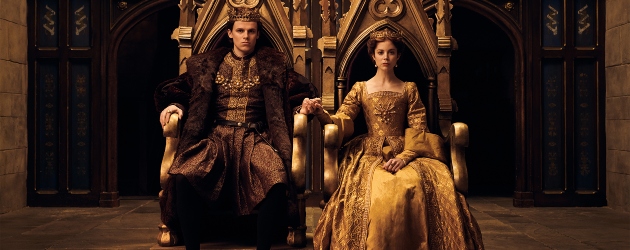The Spanish Princess returns tonight with its second season, continuing the story of Catherine of Aragon, now Queen Catherine of England and husband to King Henry VIII.
Before returning to the Tudor court, I chatted with creator and showrunner Emma Frost and showrunner Matthew Graham about the time jump, how the women in this story found their agency, and showing a side of Queen Catherine and King Henry that is often overlooked in other screen adaptations of their story.
Please note there are a few minor details revealed below about the upcoming season.
Part Two of The Spanish Princess begins today, October 11, on Crave in Canada and Starz in the US.
There is a time jump at the start of this season. Why you chose this specific period of time to resume the story?
Emma: We wanted to start at the height of Catherine and Henry’s success, power and happiness, when they were rock stars and had everything they ever wanted. It felt like a natural reset from where we left off the season before, and it allows the story to slowly come back around.
Matthew: We also really wanted to get into the story of Princess Mary, who married Louis XII of France, and age her up to young adulthood
Emma: A difficult challenge in this show is there are so many children and time moves fast. You have to find a point somewhere where you recast and allow our children to become adults.
When it comes to the women on The Spanish Princess, you’ve been able to walk that line between what they’re capable of and what’s expected of them. In your research for this show, were you surprised to discover that these women had what would be considered more modern sensibilities?
Emma: One of the things that we were excited to dig into in this season was Henry’s sisters: Meg, Princess Margaret of Scotland and Princess Mary. There’s a there’s an arrogance and an entitlement that runs through all of the Tudor characters. That was quite thrilling for us because it feels very modern. For the first time, in all the iterations of this story, the women are modern in saying, “I’ll figure out my own destiny, thanks. Don’t try and order me around.”
There’s naturally a tension between what is expected of women and their brother being the King of England. He’s a man and the one who, in theory, gets to dictate their lives. Meg and Mary both really resist that. One of my favourite aspects of this season is how Mary ultimately finds her own way through it. And Meg does something that is that is true historically, and might surprise a lot of people.
Matthew: Meg inadvertently inspires Henry into a course of action that doesn’t benefit Catherine. The truth is that [the women] didn’t have a lot of agency, yet they found agency in real life. They found ways of making a difference, influencing their court and the country. The fact that they had to do it in light of being almost second class compared to the men makes what they achieved all the more incredible.
Emma: Women finding a different way through something — a different route to power and to the outcome that they want — has a really modern resonance. That’s partly why the show resonates with audience because there’s so much we recognize, and the power battles that we’re still dealing with now.
What has really set The Spanish Princess apart from other screen adaptations of Tudor history is how you spend the time on Catherine and Henry’s relationship and how it begins to fall apart, mainly in them trying to produce a male heir. Showing a couple struggling with fertility is something modern audiences can relate to as well.
Matthew: We don’t follow just a downward trajectory for their marriage. It was very important to us that Catherine and Henry overcame obstacles together. In one of the episodes, you’ll see the pain and suffering that’s pulling them apart, and how they find ways to try and rebuild.
Emma: We wanted this season to be a celebration of their love. One of the things people don’t realize about Catherine and Henry is that she was the love of his life. They were together for 24 years, and he wouldn’t even have married her if there wasn’t genuine passion there because on paper, there were better wives. That is always glossed over. All anyone ever thinks they know about Catherine of Aragon and is that she’s the dumpy, unwanted first wife who was ditched for Ann Boleyn, and that’s not the truth. Their story was more real and human and complex. Henry wasn’t born a monster, and Catherine wasn’t this boring old baggage. There’s an extraordinary journey that that takes them there, and what was amazing for Matthew and I to explore was that very real love, and the particular pressures of being a queen and a king.
On top of that is the pressures of fertility, the pain and struggle of trying to produce children, and trying to produce a male heir particularly. That, in the end, makes them completely unequal because Catherine bears all the blame. We get to tell a more sympathetic and interesting story about how he becomes Henry VIII. We show incredibly relatable marital difficulties and hope you feel the pathos of the tragedy, but also see that their triumphs and love are very real.
There’s also Catherine’s guilt over the lie she told about her marriage to Arthur, and whether she’s cursed for that lie.
Emma: Catherine is bound up in this guilt, and at the centre of the show is this lie. She’s running as fast as she can away from it, and it’s catching up a lot quicker than she can run.



